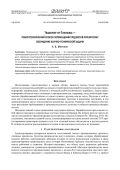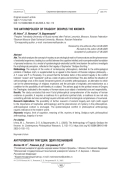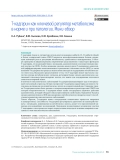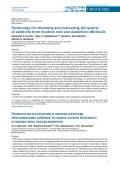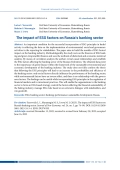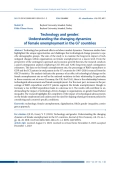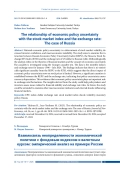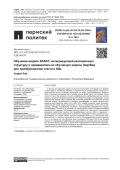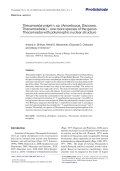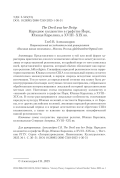Перемещение предметов перебросом — это перспективный способ робототехнической транспортировки деталей в гибких производственных системах. В данном обзоре рассматриваются задачи, связанные с реализацией этого подхода. В кратком введении в современные системы транспортировки обсуждаются недостатки традиционного конвейерного подхода. Дается обзор исследований по транспортировке путем броска и захвата (Transport-by-Throwing, TbT). Обсуждается важный аспект перемещения перебросом, связанный с прогнозированием траектории летящего тела. Рассматриваются соответствующие задачи и подходы к их решению.
Цель. В статье анализируются понятие тайны как онтологической матрицы человеческой природы и феномен экзистенциального переживания, приводящего к конфликту познающего интеллекта и непостижимого основания личностного бытия. В качестве модели механизма гносеологически-экзистенциального конфликта исследуется мифологическое мироощущение, отражённое в трагедии Софокла «Царь Эдип».
Процедура и методы. Анализ работ современных философов, посвящённых антропологической проблеме мифа об Эдипе, дополнен обращением к классикам русской религиозной философии – А. Ф. Лосеву и П. А. Флоренскому. Доказывается, что формообразующим фактором античной трагедии является конфликт «усийной» и «ипостасной» вины как столкновения рода и индивида. Этим же определена ситуация кризиса самопознания в замкнутых имманентных системах научного антропологизма, альтернативой которым могут стать феноменология религиозной мистики и принцип энигматического антиредукционизма как условия возможности самотождественности субъекта. Авторы исследуют духовные стихи Григория Богослова, посвящённые тайне человеческой природы как объекту экзистенциальной заботы и ответственности.
Результаты. В ходе исследования делается вывод, что даже если полное философское постижение природы человека и возможно, оно требует от постигающего особого духовного состояния, готовности к встрече как с предельным, так и с запредельным во всей онтологической полноте ноуменального.
Практическая и/или теоретическая значимость исследования. Намечается возможность дальнейшего исследования как античной трагедии и мифа (с учётом значимости антропологического наследия Софокла), так и феномена тайны в философско-антропологическом контексте. Гносеологический конфликт в философской антропологии вновь обретает актуальность в современном мире.
В статье ставится вопрос о качественном измерении информационных процессов. Изолированность человека от коммуникативных инструментов практически свела к нулю рефлексию о причастности субъекта к информационному потоку. Однако при этом проблема причастности личности к событиям в мире является важным онтологическим ориентиром: развиваясь вместе с миром, человек развивается и сам, и это взаимообусловленные процессы. Еще до начала конкретного акта коммуникации возникает удвоение субъекта, и это событие во многом является смыслообразующим моментом. Можно утверждать, что именно оно важнее чем возможный, верифицируемый «эффект» информационного взаимодействия. Театральность и перформативность коммуникативного процесса являются следствием этого необходимого удвоения, что, в свою очередь, подразумевает конформность субъекта, который должен учитывать роли окружающих его людей. Возникает феномен эксплицированной идентичности, в которой внешние формы самопроявления личности образуют самостоятельную парадигму, вступающую в диалоговые отношения с сугубо внутренним миром личности. Эксплицированность, внешняя выраженность становятся субъектным отражением коммуникативного процесса, имеющего, в отличие от межчеловеческого общения, четкую технологическую компоненту. В данном контексте начинает проявляться новое качество свободы субъекта. Она дает о себе знать и в овладении коммуникативными технологиями, и в отпускании во внешний мир собственных страхов и переживаний, и, что особенно важно, в получении извне подтверждений субъектной значимости. Именно это и есть истинный результат коммуникации, который является следствием социального творчества. Игровой характер этих процессов очевиден, что вновь подтверждает уже выдвинутую автором гипотезу о том, что игра является способом субъектного зондирования границ между различными дихотомиями. Культура в этом контексте становится неким набором правил, смысловым каркасом для проявления игровой сути коммуникации и в этом смысле может трактоваться как своего рода геймплей для творчески активного субъекта.
Статья представляет собой анализ растущей роли Telegram-каналов как инструмента формирования повестки дня в современных медиа-экосистемах, с особым акцентом на Россию. В исследовании акцентируется внимание на значительных изменениях в паттернах медиапотребления, выделяя Telegram как платформу, способную обходить традиционные медиа-фильтры, предоставляя возможность прямого и неотфильтрованного распространения новостей и общественных мнений. В работе рассматриваются политические, технологические и регуляторные контексты, которые способствовали расцвету Telegram, ставшего доминирующим источником информации в условиях ограничений иностранных платформ. Особое внимание уделяется способности Telegram предоставлять немедленный доступ к информации, что стало особенно важным в условиях, когда традиционные средства массовой информации сталкиваются с нарастающими ограничениями. В рамках исследования отмечается, что структура Telegram, построенная на децентрализованной сети каналов, кардинально изменяет медиапейзаж, предоставляя как профессиональным журналистам, так и обычным пользователям возможность быть не только создателями контента, но и установщиками повестки дня. Сравнив Telegram-каналы с другими цифровыми медиа, автор исследует их эффективность в воздействии на общественное восприятие, особенно в контексте формирования альтернативных политических нарративов, которые могут быть исключены из основного информационного поля. В заключение автор утверждает, что Telegram-каналы существенно трансформировали механизмы распространения информации, став важным инструментом в развитии общественного дискурса и политического принятия решений в цифровую эпоху.
T-кадгерин (также в литературе используются названия cadherin 13, H-cadherin ( heart) и белок, кодируемый геном CDH13) является многофункциональным белком, играющим ключевую роль в регуляции метаболизма, адипогенеза и канцерогенеза. В обзоре приведены и сформулированы современные представления о структуре и функциях T-кадгерина, его взаимодействии с лигандами, адипонектином и липопротеинами низкой плотности (ЛНП). Особое внимание уделено анализу роли T-кадгерина в адипогенной дифференцировке мезенхимальных стромальных/стволовых клеток (МСК), а также влиянию T-кадгерина на процессы накопления липидов и поддержания метаболического гомеостаза. Высказано предположение о том, что T-кадгерин может выступать в качестве сенсора метаболических сигналов, регулируя баланс между адипогенезом и активацией стволовых/прогениторных клеток, что важно для поддержания клеточного гомеостаза жировой ткани.
В контексте онкологических заболеваний T-кадгерин функционирует как потенциальный опухолевый супрессор. Потеря экспрессии T-кадгерина характерна для многих типов рака, включая рак молочной железы, легких и колоректальный рак. Снижение уровня T-кадгерина может быть связано с гиперметилированием промотора гена CDH13 или потерей гетерозиготности. T-кадгерин может также опосредовать защитное действие адипонектина, который обладает онкосупрессивными свойствами. Нарушение баланса между адипонектином и ЛНП при ожирении и метаболическом синдроме может способствовать развитию онкологических заболеваний.
Таким образом, T-кадгерин может опосредовать взаимосвязь процессов ожирения и канцерогенеза. Способность T-кадгерина регулировать адипогенез и взаимодействовать с лигандами, влияющими на метаболизм в целом, делает его перспективной мишенью для дальнейших исследований. Понимание молекулярных механизмов участия T-кадгерина в этих процессах может открыть новые подходы к лечению ожирения и связанных с ним онкологических заболеваний.
Enrichment of food products with non-traditional plant raw materials, characterized by availability and high nutritional value due to the content of biologically active substances, is a relevant area of research in the field of technology of food systems with a given composition and properties. Burdock root and dandelion root are distinguished by a rich mineral composition, high content of fiber and inulin, which determines the possibility of their use for enrichment of food products. In this regard, the purpose of the study boils down to developing a technology for obtaining powders from burdock root and dandelion in a catering establishment for the production of food products, as well as assessing their quality and safety. As a result of using various drying methods (in a dehydrator and a drying cabinet with forced ventilation) in the conditions of a public catering establishment, optimal process parameters were established (temperature 100 °C, duration 6 h) and a technology for obtaining enriching additives from the roots of burdock and dandelion was developed. The content of the main biologically active substances in additives from the roots of burdock ((42.6 ± 0.29) % inulin, (1646.0 ± 1.25) mg/kg magnesium) and dandelion ((61.6 ± 0.33) % inulin, (1481.6 ± 0.95) mg/kg magnesium), obtained according to the developed technology, was determined. The authors determined that over 18 months the powders from the roots of burdock and dandelion met the requirements. The scheme of the technological process of obtaining is presented, regulated physical and chemical indicators of quality of powdered food additives from the roots of burdock and dandelion are determined. Powders from plant raw materials obtained in the conditions of a public catering enterprise have potential for use in further research aimed at developing fortified food products, including culinary dishes, with increased content of magnesium and inulin
An important condition for the successful incorporation of ESG principles in banks’ activity is reflecting the data on the implementation of environmental, social and governance activities in the reporting for stakeholders. The paper aims to build the models of ESG factors’ impact on the banking industry. Methodologically, the study rests on the theories of ESG banking and green (responsible) finance and uses the methods of dialectical and economic statistical analysis. By means of correlation analysis the authors reveal causal relationships and establish the ESG factors affecting the banking sector of the Russian Federation. The obtained data point to the importance of green finance within the framework of the sustainable environmental and economic development of the banking industry. The study does not fully confirm the thesis that following the ESG principles will lead to an increase in the profitability and efficiency of the banking sector: only social factors directly influence the performance of the banking sector, while environmental factors have an inverse effect, and there is no relationship with the governance factors. The findings can be useful while incorporating ESG principles in the regulation of financial markets and in investment practices. This will enable the organisations in the banking sector to form an ESG-based strategy, control the factors affecting the financial sustainability of the baking industry, manage ESG risks based on an extensive dialogue with stakeholders, and win goodwill
Technology has profound effects on labour market dynamics. Numerous studies have highlighted the unique opportunities and challenges that technological change presents to specific demographic groups. The aim of the study is to examine the long-term impact of technological changes within organisations on female unemployment at a macro level. From the perspective of the contingency approach and economic growth theories, the research conducts a panel cointegration analysis employing CCE-MG and AMG long-term panel cointegration estimators. The data on the female unemployment rate, the percentage of R&D expenditure in GDP and the ICT patents in total patents in the G7 countries for 1985–2020 is sourced from the OECD statistics. The analysis indicates the presence of an effect of technological change on the female unemployment rate as well as the national variations in their relationship. In particular, in three countries out of seven (Germany, the UK, the USA), there is the relationship between technological advancements and female unemployment. For the most part, increases in the percentage of R&D expenditure and ICT patents augment the female unemployment, though in Germany a rise in R&D expenditure leads to a decrease in it. The results will contribute to understanding the impact of technology-driven changes in organisations on gender-based labour inequality. The research highlights the complexity of the impact of technological advancements on the female employment and underscores the need for shaping related government policies by considering each country’s specific conditions
National economic policy uncertainty is a determinant of stock market volatility, decreased investor confidence, and macroeconomic instability. The study aims to examine the interaction between Russia’s Economic Policy Uncertainty Index (REPU), the Moscow Stock Exchange RTS Index (RTSI) and the exchange rate of US dollar to Russian ruble. Methodologically, the analysis relies on the theories of financial markets and the concept of economic uncertainty. The causality is investigated using the Granger causality test. The data is the monthly indices and exchange rates for January 1996 – July 2024. The findings indicate that there is no statistically significant causality from the REPU to the RTSI, which suggests that the direct impact of economic policy uncertainty news on stock prices is limited. However, a significant causation is established between the REPU and the exchange rate, indicating that policy uncertainty causes currency depreciation. This evidences that economic policy uncertainty plays an important role in exchange rate fluctuations. The insights derived from the study could help policymakers and investors assess issues related to financial stability and exchange rate risks. In future, the study could be extended to examine other macroeconomic indicators and external shocks influencing financial markets
В данном исследовании модуль реляционного внимания интегрируется в предобученную модель Transformer Seq2Seq и осуществляется преобразование вопросов на естественном языке в команды извлечения на языке структурированных запросов (SQL) с помощью экспериментов на наборе данных Spider. Цель этой научной статьи состоит в том, чтобы улучшить точность и эффективность преобразования текста в SQLзапросы, используя механизм реляционного внимания в модели трансформера. Статья представляет модель RASAT (переход SQL на основе реляционного внимания), которая заменяет модуль самовращения в энкодере трансформера на модуль реляционного внимания для обработки задач текст-к-SQL. Этот подход позволяет лучше учитывать семантические связи между сущностями в тексте и генерировать более точные SQLзапросы. Методы исследования включают использование предобученной модели трансформера (T5-small) и ее обучение на наборе данных Spider с введением модуля реляционного внимания. Экспериментальные результаты показывают значительное улучшение показателей точности при преобразовании текста в SQL по сравнению с базовой моделью без реляционного компонента. Экспериментальные результаты демонстрируют, что модель RASAT улучшает производительность по показателю Exact Match на 1,82 % и точность выполнения на 3,26 %. Эти улучшения достигнуты несмотря на то, что количество эпох обучения было ограничено 500 вместо 3072 для базовой модели, что подчеркивает эффективность предложенного подхода даже при ограниченных вычислительных ресурсах. В заключение подчеркиваются перспективы дальнейшего развития метода реляционной модели для улучшения качества систем, связанных с обработкой естественного языка и базами данных.
Thecamoeba onigiri n. sp. (Amoebozoa, Discosea, Thecamoebida) was isolated from a moss sample collected in the surroundings of Lake Baikal (Russia). The amoebae of this species belong to the striate morphotype and have a single rounded nucleus. The nucleolar material of T. onigiri can be organized in different ways depending on the age of the culture. The most common was a nucleus with a nearly spherical eccentric nucleolus, sometimes located very close to the nuclear envelope. The surface of such a nucleolus was rough and uneven. This type of nucleolar organization was observed in one- to two-week-old cultures. In contrast, a centrally located rounded nucleolus with smooth surface predominated in three- to four-week-old cultures. This type of the nucleolus corresponds to the classical “vesicular” nucleus and is similar to that found in amoebae of “T. quadrilineata species group”, but differs in having lacunae that are more peripheral. Molecular phylogenetic analysis based on 18S rRNA gene sequences showed that T. onigiri forms a clade with T. astrologa as part of a larger group that also includes the “T. quadrilineata species group” and T. aesculea. Meanwhile, two species of Thecamoeba demonstrate polymorphism of the nucleolar material arrangement, and both these species are phylogenetically close.
Представления о колдовстве в той или иной форме характерны практически для всех человеческих обществ и зачастую неотделимы от представлений религиозных, по крайней мере от того комплекса идей, представлений и практик, который обычно обозначают как народную религию, folk religion. Специфика народной религиозности на территории нынешних Южных штатов США в колониальный период остается относительно малоизученной, в первую очередь вследствие недостатка источников. Тем не менее до определенной степени она может быть реконструирована благодаря доступным сегодня материалам, собранным и обработанным интересующимися локальной историей представителями местных элит. Настоящая статья посвящена народному колдовству и «низовой» религиозности в графстве Йорк, Южная Каролина, в XVIII–XIX вв. В статье рассматриваются локальные особенности, отличающие народную культуру Южных колоний, в частности Каролины, и от Европы, и от других английских колоний, эволюция народной религиозности в колониальный период и в первые десятилетия после обретения США независимости, а также ее влияние на формирование специфической южной религиозности.
